Realizing Loose Communication with Tangible Avatar to Facilitate Recipient’s Imagination †
Abstract
:1. Introduction
2. Related Work
2.1. SNS Fatigue
2.2. Communication Support Systems
2.3. End-User Design of Daily Objects
3. The Design and Implementation of Palco
3.1. Key Features
3.1.1. Tangible Avatar-Based Communication
3.1.2. Loose Communication
3.1.3. Being Printable
3.2. System Components
3.3. Information to Be Presented
3.4. Prototype System Implementation
3.4.1. Apparatuses and Software Libraries
3.4.2. Acquiring the Partner’s States
3.4.3. Projecting Images
4. User Study
4.1. Methodology
4.2. Hypotheses
4.3. Result of Concept Validation
4.3.1. Impressions on the Tangible Avatar
- -1
- Rectangle detection was unstable. (A, D, J)
- -2
- I was concerned about what it would be like when moving avatars to the left and right. (C, F)
- -3
- I experimented in the range visible through movement. (C, I)
- -4
- I touched it at break-time because I had nothing to do. (B, G)
- -5
- I think I did not touch it with a simple doll. (B)
- -6
- I touched it when I found something interesting in the projected image. (E, J)
- -7
- I felt a sense of familiarity due to the animated facial expressions.(A, D, E, G, H, I, J)
- -8
- Once I got used to Palco, I concentrated on my work and I did not mind the existence of the avatar. (B, C, E, I, J)
- -9
- I felt that the avatar stood there naturally. (C, F)
- -10
- Not much motivation was needed to switch my gaze to the avatar. (D)
- -11
- The partner was naturally reflected in the avatar. (E)
4.3.2. Impression on Passive Communication
4.3.3. Impressions with Respect to the Presentation of Abstract Information
- -1
- I do not get tired of seeing dopey. (A, B, C, F, G, H, J)
- -2
- Facial expression is a cue to think of the partner. (A, B)
- -3
- First, I look at the information shown through the body and can see emotional state from there. (B)
- -4
- I can imagine the state more specifically with the activity information. (B, C, D, E, H)
- -5
- I felt relieved when I knew the location of the partner. (E, I, A, D, I)
- -6
- Just by knowing what the partner is doing now, I can guess a certain partner’s location. (C)
- -7
- It is better to combine the types of information. (A, E, J)
4.3.4. Conversation Triggered by Palco
- -1
- It was different from the schedule heard in advance. Did you have something? (A)
- -2
- Did it not work very well when you were practicing the piano? (A)
- -3
- Why did you get angry yesterday? (H)
- -4
- Why were you crying at the part-time job? (B)
- -5
- Were you asleep while working at home? Or just sleepy? (D)
- -6
- Is it due to yesterday’s party that you were late today? (C)
- -7
- Conversation was triggered with not only the partners but also those who were seeing the same information. (B, E)
4.3.5. Attributes and Daily Relationships with the Communication Partner
5. Discussion
5.1. Effect of a Tangible Avatar as a Communication Tool
5.2. Effect of Loose Communication on the Relationship between the User and the Partner
5.3. Communication Triggered by the Information on Avatar
5.4. Impact of the Daily Relationship between the User and the Partner
6. Conclusions and Future Work
- The tangible avatar became a communication tool through its physicality and anthropomorphic characteristics.
- A preference with respect to the level of activeness, i.e., active or passive, in communication varies depending on the daily relationship with the partner. Additionally, the preference may also be affected by the temporal impression on the partner, such that the user may want to reply to a partner who shows different states from the user.
- The presentation of abstract information by projecting current partner states is useful for maintaining relations with the communication partner.
- There is an effect of urging the users to talk with their partner when the projection information concerns them.
- Not only daily relationships but also the user’s interests in the communication partner affect the user’s attitude.
Acknowledgments
Author Contributions
Conflicts of Interest
References
- Facebook. Available online: https://www.facebook.com/ (accessed on 15 December 2017).
- Twitter. Available online: https://twitter.com/ (accessed on 15 December 2017).
- Instagram. Available online: https://www.instagram.com/?hl=ja (accessed on 15 December 2017).
- Miyagi, Y. Diversifying purpose of use of SNS. Life Des. Rep. 2012, 202, 42–44. (In Japanese) [Google Scholar]
- Research on the Possibility of Realization of Next Generation ICT Society. 2011. Available online: http://www.soumu.go.jp/johotsusintokei/linkdata/h23_05_houkoku.pdf (accessed on 15 December 2017). (In Japanese).
- Survey on the Internet Use of Young People and Dependency Trends. 2013. Available online: http://www.soumu.go.jp/iicp/chousakenkyu/data/research/survey/telecom/2013/internet-addiction.pdf (accessed on 15 December 2017). (In Japanese).
- Relationships Indicator Survey 2011. Available online: http://www.relationships.org.au/what-we-do/research/australian-relationships-indicators/relationships-indicator-2011 (accessed on 15 December 2017).
- Krasnova, H.; Wenninger, H.; Widjaja, T.; Buxmann, P. Envy on Facebook: A hidden threat to users’ life satisfaction? Wirtschaftsinformatik 2013, 92, 1–16. [Google Scholar]
- Endo, S.; Fujinami, K. Palco: Printable Avatar System That Realizes Loose Communication Between People. In Proceedings of the IEEE 6th Global Conference on Consumer Electronics (GCCE), Nagoya, Japan, 24–27 October 2017; pp. 671–672. [Google Scholar]
- Maier, C.; Laumer, S.; Eckhardt, A.; Weitzel, T. Giving too much social support: Social overload on social networking sites. Eur. J. Inf. Syst. 2015, 24, 447–464. [Google Scholar] [CrossRef]
- Lee, A.R.; Son, S.M.; Kim, K.K. Information and communication technology overload and social networking service fatigue: A stress perspective. Comput. Hum. Behav. 2016, 55, 51–61. [Google Scholar] [CrossRef]
- Misawa, K.; Rekimoto, J. Chameleonmask: Embodied physical and social telepresence using human surrogates. In Proceedings of the 33rd Annual ACM Conference Extended Abstracts on Human Factors in Computing Systems, Seoul, Korea, 18–23 April 2015; ACM: New York, NY, USA, 2015; pp. 401–411. [Google Scholar]
- Brereton, M.; Soro, A.; Vaisutis, K.; Roe, P. The messaging kettle: Prototyping connection over a distance between adult children and older parents. In Proceedings of the 33rd Annual ACM Conference on Human Factors in Computing Systems, Seoul, Korea, 18–23 April 2015; ACM: New York, NY, USA, 2015; pp. 713–716. [Google Scholar]
- Kato, R.; Kazuaki, T.; Hideyuki, N. RicketyBench: A Bench Type Remote Conference System which Reproduces a Sense of a Person Sitting Next to. IPSJ SIGUBI 2014, 2014, 1–5. (In Japanese) [Google Scholar]
- Tsujita, H.; Tsukada, K.; Siio, I. Appliances to Arouse Mutual Awareness between Close People Separated by Distance, “SyncDecor”. Comput. Softw. 2009, 26, 25–37. [Google Scholar]
- Miyajima, A.; Itoh, Y.; Itoh, M.; Watanabe, T. “Tsunagari-kan” communication: Design of a new telecommunication environment and a field test with family members living apart. Int. J. Hum.-Comput. Interact. 2005, 19, 253–276. [Google Scholar] [CrossRef]
- Chien, W.C.; Hassenzahl, M.; Welge, J. Sharing a Robotic Pet as a Maintenance Strategy for Romantic Couples in Long-Distance Relationships: An Autobiographical Design Exploration. In Proceedings of the 2016 CHI Conference Extended Abstracts on Human Factors in Computing Systems, San Jose, CA, USA, 7–12 May 2016; ACM: New York, NY, USA, 2016; pp. 1375–1382. [Google Scholar]
- Nakagawa, M.; Tsukada, K.; Siio, I. Calmate: Communication support system for couples using a calm avatar. In Proceedings of the 2012 ACM Conference on Ubiquitous Computing, Pittsburgh, PA, USA, 5–8 September 2012; ACM: New York, NY, USA, 2012; pp. 604–605. [Google Scholar]
- Kowalski, R.; Loehmann, S.; Hausen, D. Cubble: A multi-device hybrid approach supporting communication in long-distance relationships. In Proceedings of the 7th International Conference on Tangible, Embedded and Embodied Interaction, Barcelona, Spain, 10–13 February 2013; ACM: New York, NY, USA, 2013; pp. 201–204. [Google Scholar]
- Kim, J.; Park, Y.W.; Nam, T.J. BreathingFrame: An Inflatable Frame for Remote Breath Signal Sharing. In Proceedings of the Ninth International Conference on Tangible, Embedded, and Embodied Interaction, Stanford, CA, USA, 15–19 January 2015; ACM: New York, NY, USA, 2015; pp. 109–112. [Google Scholar]
- Hassib, M.; Buschek, D.; Wozniak, P.W.; Alt, F. HeartChat: Heart Rate Augmented Mobile Chat to Support Empathy and Awareness. In Proceedings of the 2017 CHI Conference on Human Factors in Computing Systems, Denver, CO, USA, 6–11 May 2017; ACM: New York, NY, USA, 2017; pp. 2239–2251. [Google Scholar]
- Chang, A.; Resner, B.; Koerner, B.; Wang, X.; Ishii, H. LumiTouch: An emotional communication device. In Proceedings of the CHI’01 Extended Abstracts on Human Factors in Computing Systems, Seattle, WA, USA, 31 March–5 April 2001; ACM: New York, NY, USA, 2001; pp. 313–314. [Google Scholar]
- Joi, Y.R.; Jeong, B.T.; Kim, J.H.; Park, K.H.; Lee, T.; Cho, J.D. WearLove: Affective Communication via Wearable Device with Gamification. In Proceedings of the 2015 Annual Symposium on Computer-Human Interaction in Play, London, UK, 5–7 October 2015; ACM: New York, NY, USA, 2015; pp. 559–564. [Google Scholar]
- Patel, D.; Agamanolis, S. Habitat: Awareness of life rhythms over a distance using networked furniture. In Proceedings of the Fifth International Conference on Ubiquitous Computing UbiComp 2003, Seattle, WA, USA, 12–15 October 2003. [Google Scholar]
- Tsetserukou, D.; Neviarouskaya, A. World’s first wearable humanoid robot that augments our emotions. In Proceedings of the 1st Augmented Human International Conference, Megève, France, 2–3 April 2010; ACM: New York, NY, USA, 2010; p. 8. [Google Scholar]
- FabLab Japan. Available online: http://fablabjapan.org/ (accessed on 15 December 2017).
- Gervais, R.; Frey, J.; Gay, A.; Lotte, F.; Hachet, M. TOBE: Tangible Out-of-Body Experience. In Proceedings of the TEI’16: Tenth International Conference on Tangible, Embedded, and Embodied Interaction, Eindhoven, The Netherlands, 14–17 February 2016; ACM: New York, NY, USA, 2016; pp. 227–235. [Google Scholar]
- Costanza, E.; Giaccone, M.; Kueng, O.; Shelley, S.; Huang, J. Ubicomp to the masses: A large-scale study of two tangible interfaces for download. In Proceedings of the 12th ACM International Conference on Ubiquitous Computing, Copenhagen, Denmark, 26–29 September 2010; ACM: New York, NY, USA, 2010; pp. 173–182. [Google Scholar]
- Willis, K.D.; Xu, C.; Wu, K.J.; Levin, G.; Gross, M.D. Interactive fabrication: New interfaces for digital fabrication. In Proceedings of the Fifth International Conference on Tangible, Embedded, and Embodied Interaction, Funchal, Portugal, 22–26 January 2011; ACM: New York, NY, USA, 2011; pp. 69–72. [Google Scholar]
- Ramakers, R.; Todi, K.; Luyten, K. PaperPulse: An integrated approach for embedding electronics in paper designs. In Proceedings of the 33rd Annual ACM Conference on Human Factors in Computing Systems, Seoul, Korea, 18–23 April 2015; ACM: New York, NY, USA, 2015; pp. 2457–2466. [Google Scholar]
- Shen, Y.; Dou, K.; Gu, J. Rocumodel: An iterative tangible modeling system. In Proceedings of the 8th International Conference on Tangible, Embedded and Embodied Interaction, Munich, Germany, 16–19 February 2014; ACM: New York, NY, USA, 2014; pp. 73–76. [Google Scholar]
- Schmitz, M. Tangible Interaction with Anthropomorphic Smart Objects in Instrumented Environments. Ph.D. Thesis, Saarländische Universitäts-und Landesbibliothek, Saarbrücken, Germany, 2011. [Google Scholar]
- Catrambone, R.; Stasko, J.; Xiao, J. Anthropomorphic agents as a user interface paradigm: Experimental findings and a framework for research. In Proceedings of the 24th Annual Conference of the Cognitive Science Society, Fairfax, VA, USA, 8–10 August 2002; Volume 24. [Google Scholar]
- Mohd Tuah, N.; Wills, G.; Ranchhod, A. The characteristics and application of anthropomorphic interface: A design spectrum. In Proceedings of the Ninth International Conference on Advances in Computer-Human Interactions, Venice, Italy, 24–28 April 2016. [Google Scholar]
- Gaver, W.W.; Beaver, J.; Benford, S. Ambiguity as a resource for design. In Proceedings of the SIGCHI Conference on Human Factors in Computing Systems, Fort Lauderdale, FL, USA, 5–10 April 2003; ACM: New York, NY, USA, 2003; pp. 233–240. [Google Scholar]
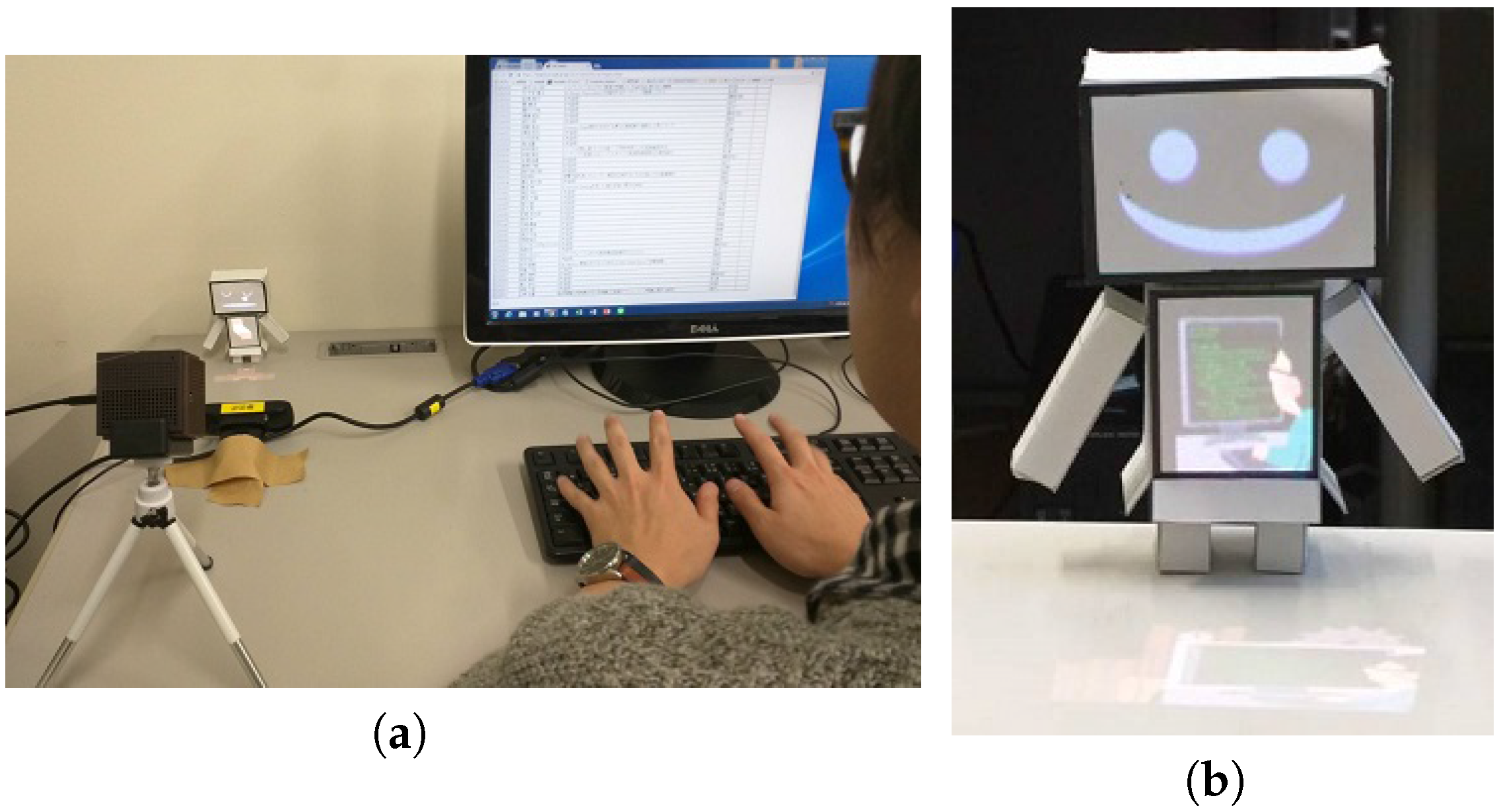
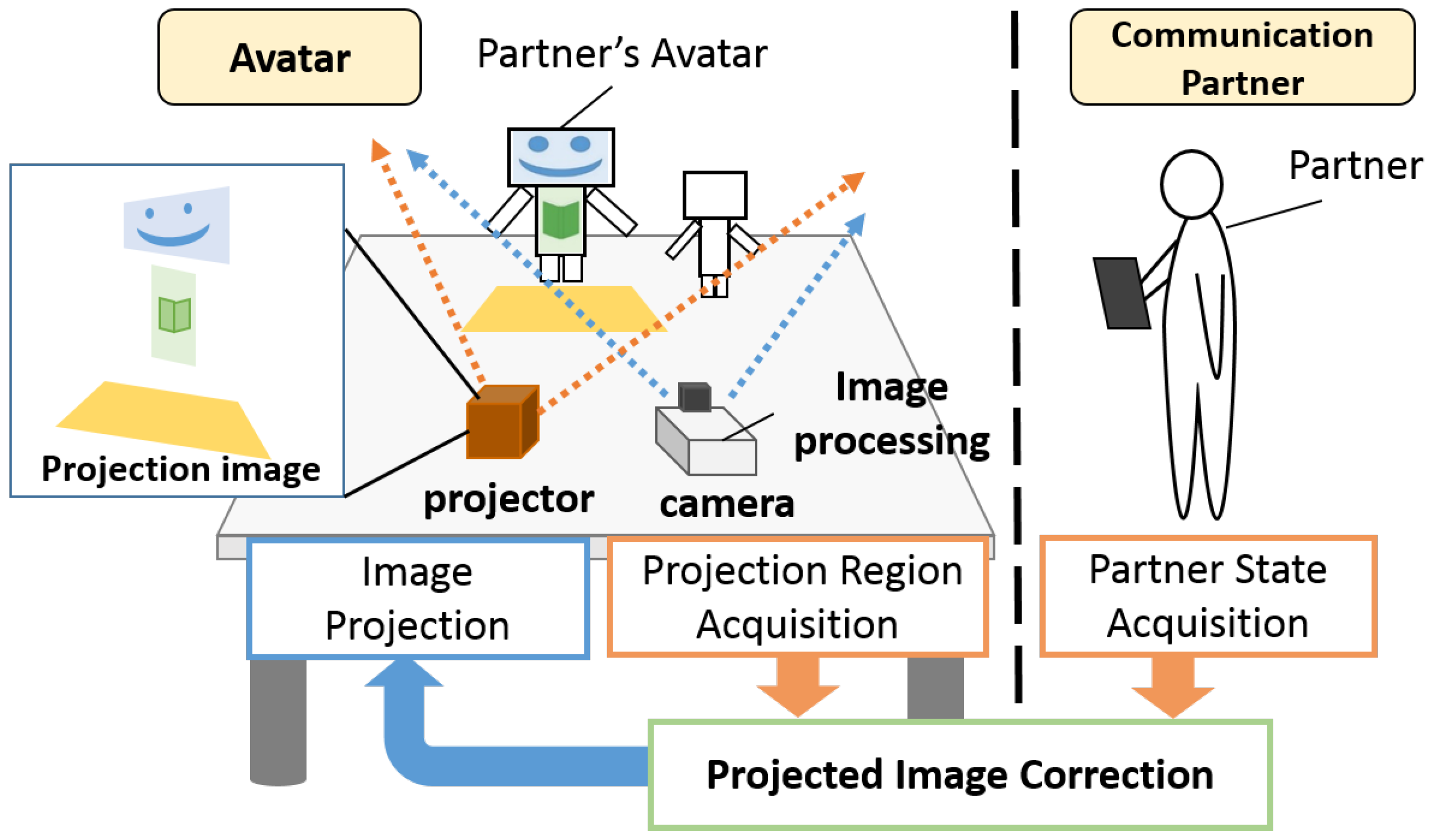
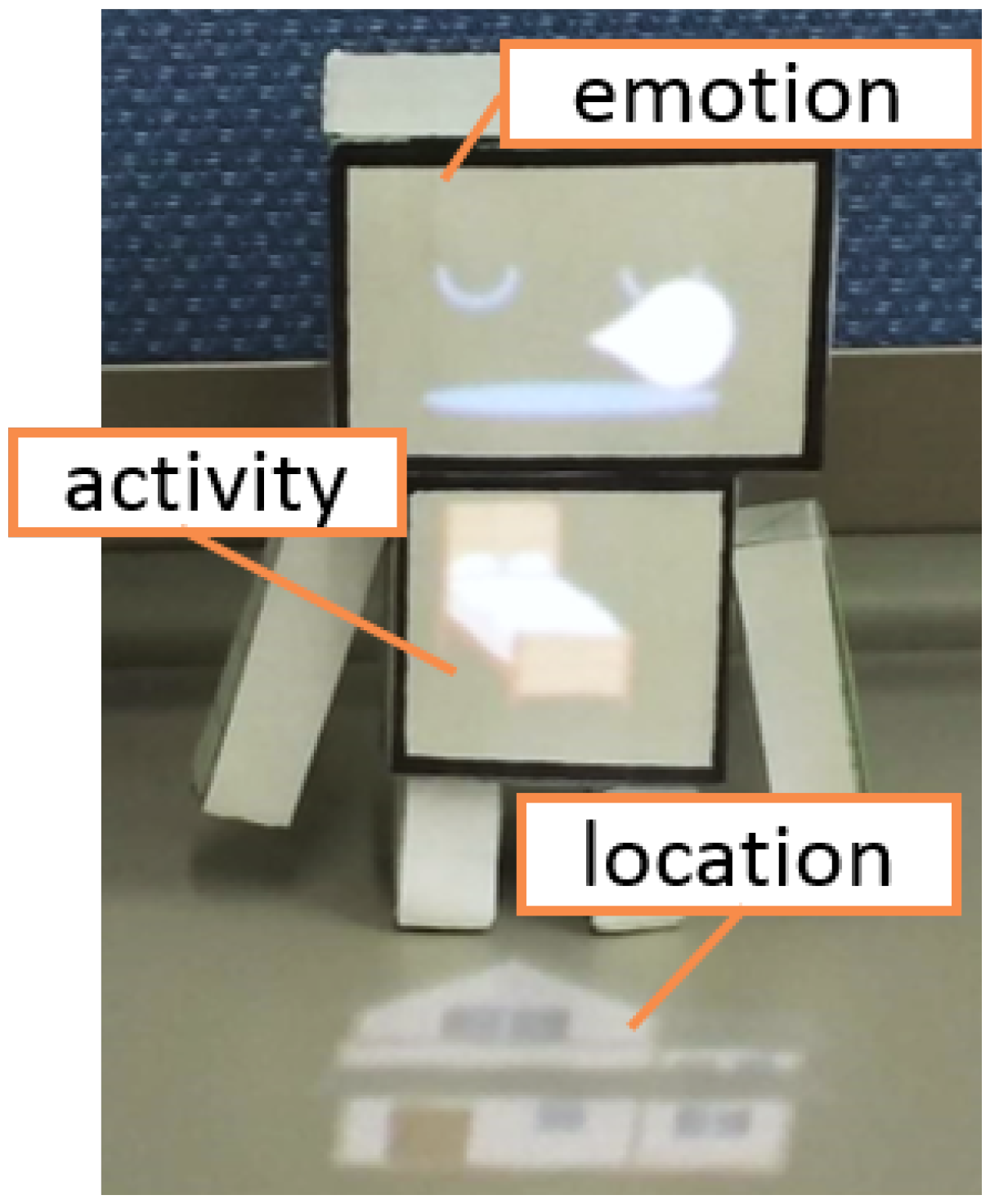
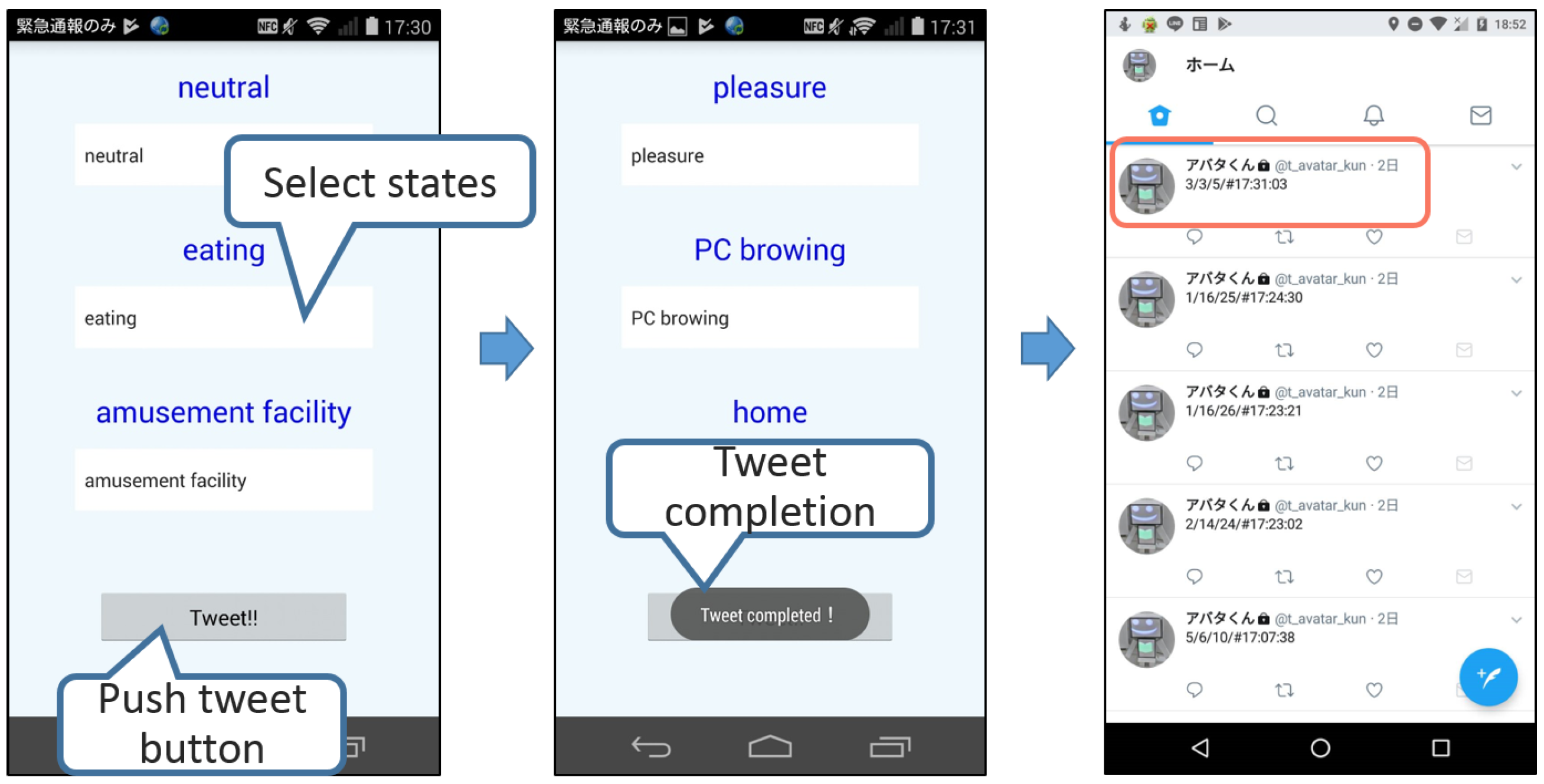

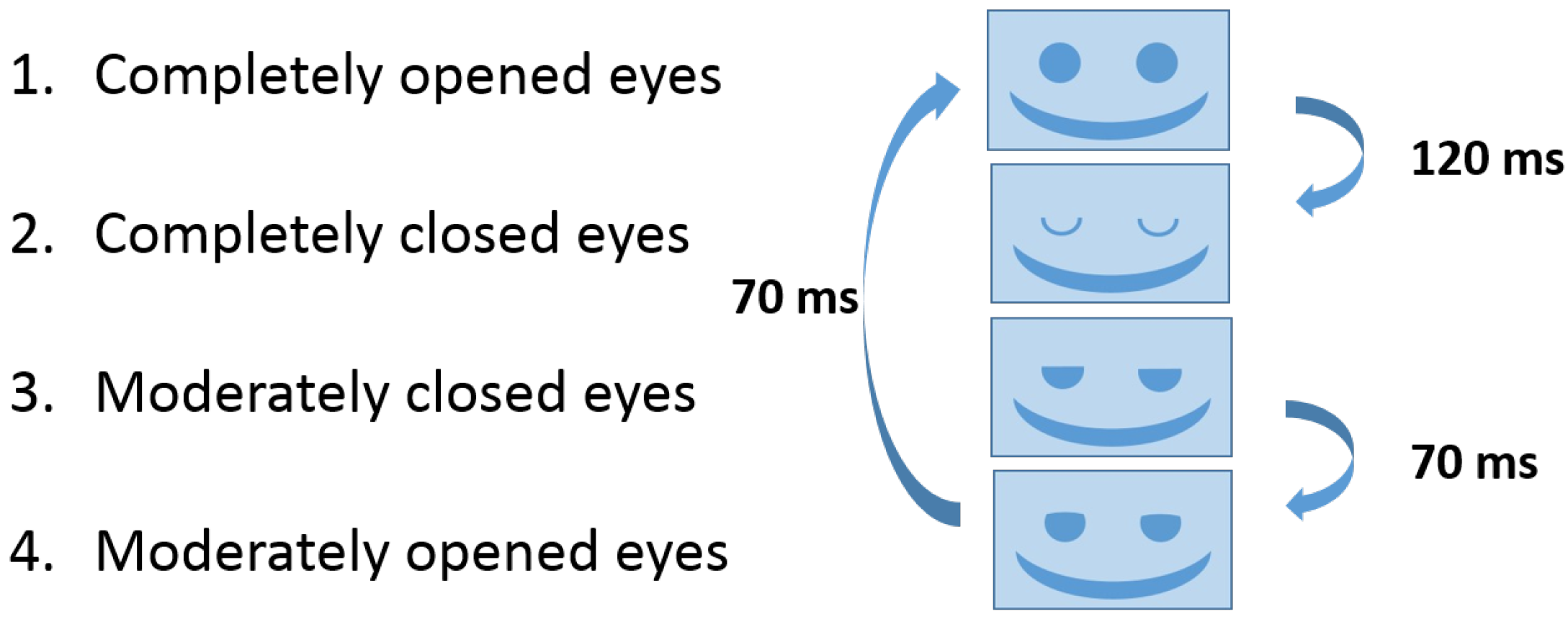

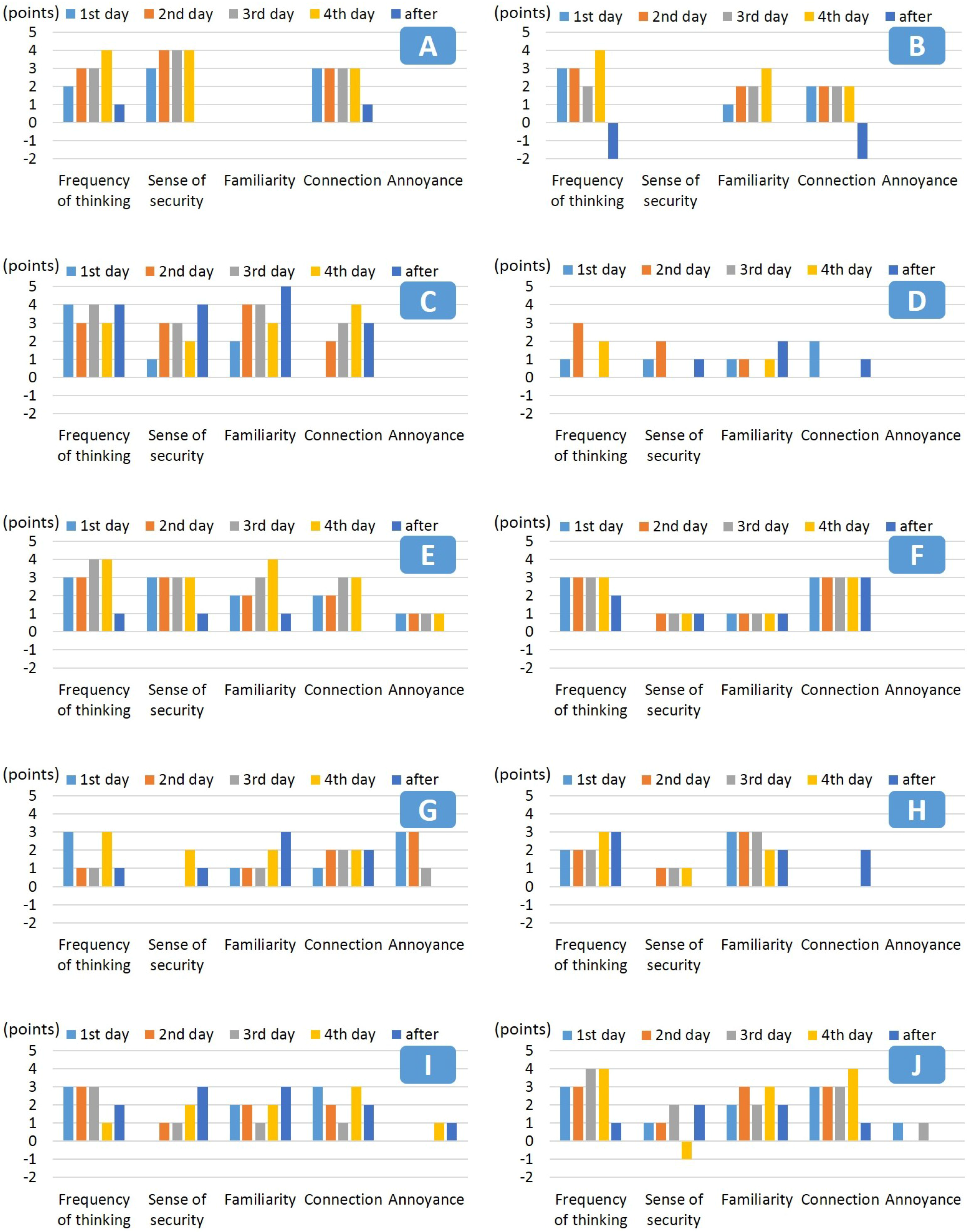
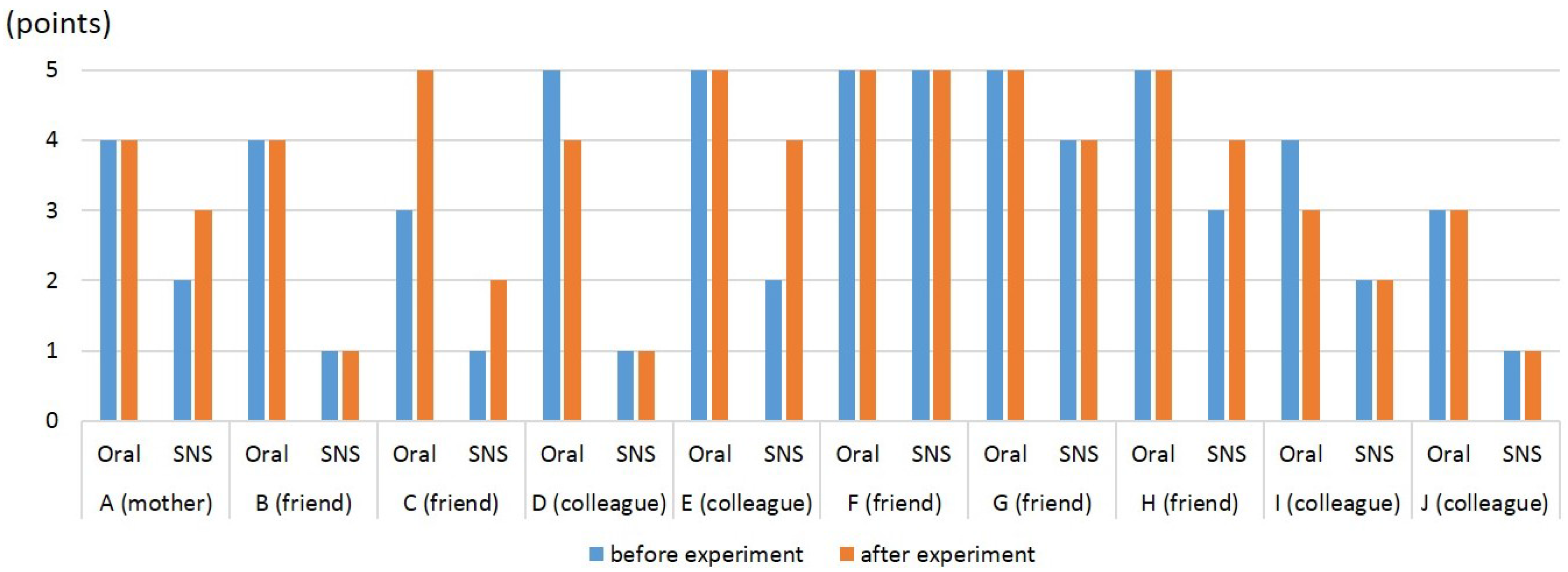

| Type of Projected Images | |
|---|---|
| emotion | neutral, happy, joyful, sad, angry, surprised, sleepy |
| activity | eating, sleeping, web browsing, reading a book, playing piano, conversation, bathing, drinking, listening to music, watching TV, using a smartphone, shopping, working on a PC, walking, watching movies, cram school teaching, drinking coffee, bowling, playing a game, calling, muscle training, exercise, cleaning, cooking, coffee serving |
| abstract location | facility, home, location of a part-time job, shop, within a train, university |
| detailed location | cinema, spa, bowling alley, concert hall, home, cram school, coffee shop, restaurant, bookstore, bar, tavern, coffee shop office (part-time job), event venue, supermarket, home appliance mass retailer, Keihin Tohoku line, Chuou line, laboratory, department store, campus cafeteria, campus library, Fuchu campus, gym |
| Participant | Opinion About Passive Communication |
|---|---|
| A (mother) E (colleague) H (friend) | -I wanted to confirm the status of my partner by e-mail. -I wanted to show a reaction to partner. |
| F (friend) G (friend) J (colleague) | -I wanted to react when Palco was sorrowful. -When Palco showed a positive emotion such as laughing, it was enough to just look. |
| C (friend) D (colleague) | -It is sufficient for one-way communication. -I also liked active communication only when I felt strong negative feelings from Palco. |
| B (friend) | -I do not think I would like to interact with Palco. -It might be interesting to tell the partner that I touched the avatar. |
| I (colleague) | -If Palco can show a reaction, I may use it out of mere curiosity. |
| Level 1 | Level 2 | Level 3 | Level 4 | |
|---|---|---|---|---|
| emotion | 4 | 4 | 4 | 3.6 |
| activity | - | - | 3.9 | 3.6 |
| location | 2.9 | 3.4 | 3.2 | 2.6 |
| Group | Characteristics/Descriptors |
|---|---|
| Group 1 | carefree, friendly, unconcerned, reliable, reassured, pleasant, not connected |
| Group 2 | carefree, friendly, concerned, reliable, a little worried, from pleasant to boring, connected |
| Group 3 | carefree, friendly, a little concerned, reliable, a little worried, pleasant, connected/not connected |
© 2018 by the authors. Licensee MDPI, Basel, Switzerland. This article is an open access article distributed under the terms and conditions of the Creative Commons Attribution (CC BY) license (http://creativecommons.org/licenses/by/4.0/).
Share and Cite
Endo, S.; Fujinami, K. Realizing Loose Communication with Tangible Avatar to Facilitate Recipient’s Imagination. Information 2018, 9, 32. https://doi.org/10.3390/info9020032
Endo S, Fujinami K. Realizing Loose Communication with Tangible Avatar to Facilitate Recipient’s Imagination. Information. 2018; 9(2):32. https://doi.org/10.3390/info9020032
Chicago/Turabian StyleEndo, Shinichi, and Kaori Fujinami. 2018. "Realizing Loose Communication with Tangible Avatar to Facilitate Recipient’s Imagination" Information 9, no. 2: 32. https://doi.org/10.3390/info9020032
APA StyleEndo, S., & Fujinami, K. (2018). Realizing Loose Communication with Tangible Avatar to Facilitate Recipient’s Imagination. Information, 9(2), 32. https://doi.org/10.3390/info9020032






